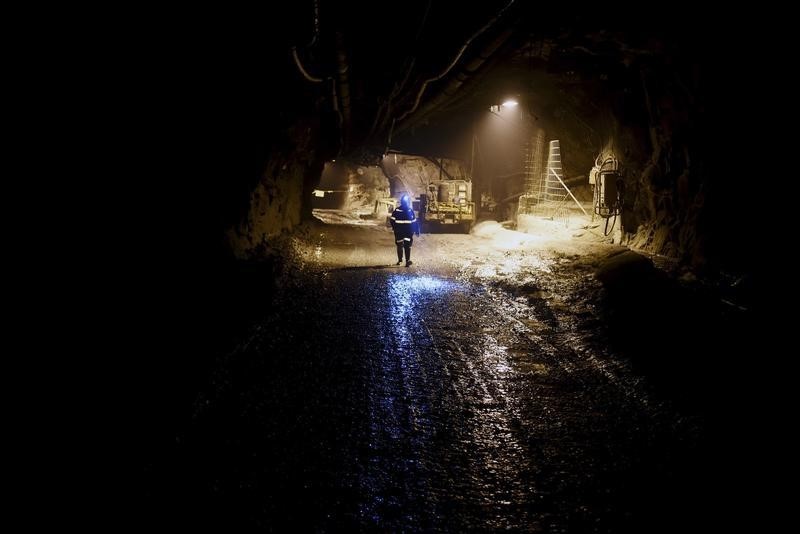(The opinions expressed here are those of the author, a
columnist for Reuters.)
By Clyde Russell
LAUNCESTON, Australia, Dec 15 (Reuters) - - One of the
largely unseen side-effects of the massive increase in iron ore
supply and the subsequent collapse in prices is that the
industry is now one of the most concentrated in the resources
sector.
As any student of economics can tell you,
highly-concentrated supply tends to lead to oligopolistic
behaviour, in which the major producers limit output in order to
drive prices higher.
This clearly hasn't happened, and isn't currently happening
in iron ore, despite about 75 percent of traded supply being
delivered by just four producers.
Morgan Stanley (N:MS) analysts Joel Crane and Tom Price wrote in a
report published on Dec. 11 that major iron ore miners now have
an incentive to exercise market power.
Traded iron ore is now the second-most consolidated
commodity, behind platinum, using the Herfindahl-Hirschman
Index, which measures company sizes against that of the
industry, according to the report.
Iron ore supply is dominated by Brazil's Vale VALE5.SA ,
followed by the giants of Western Australia's vast Pilbara
deposits, Rio Tinto (L:RIO) RIO.AX , BHP Billiton (L:BLT) BHP.AX and
Fortescue Metals Group FMG.AX .
As these companies have added hundreds of millions of tonnes
in new supply, the spot iron ore price .IO62-CNI=SI , which is
now only a fifth of its all-time high, closed at $37.50 a tonne
on Monday, just higher the $37 on Dec. 11, which was the lowest
since spot assessments started in 2008.
"What's needed to buoy the iron ore price? Vale, Rio Tinto,
BHP Billiton to end their competitive supply surge and act more
rationally in this weakened market," the analysts wrote.
"Vale's the last to deliver big tonnes to the market: if a
moderation of its supply growth strategy is followed by the
Australians, this will secure a price above that of market
expectations," Crane and Price said.
The analysts suggested that Vale could constrain supply by
slowing the ramp-up of its last major project, the 90 million
tonne per annum S11D mine, or cut output from other, higher-cost
operations.
Australian producers could then curtail their production
rate, thus changing the market dynamics and taking advantage of
the concentration of supply.
In short, the major iron ore miners need to change their
current modus operandi of behaving like players in perfect
competition to adopt a more oligopolistic approach.
HARD FOR MAJORS TO CHANGE STRATEGY
Morgan Stanley is also slightly optimistic for iron ore,
expecting a long-term price of $50-$60 a tonne, on the basis
that not only do the majors have "significant, untested pricing
power," but also that the project pipeline is closed and
high-cost output is shutting down.
There is nothing wrong about the analysis, the only caveat
is that events often unfold differently in the real world as to
how they should given what's rational and makes economic sense.
I imagine it would take a major change of heart for the iron
ore miners to turn around and exercise supply discipline.
It would have to be accompanied by some sort of
acknowledgement that their current strategy of maximising
low-cost output and competing fiercely with each other hasn't
worked.
Standing up in public, admitting you have got it wrong and
reversing strategy is probably the most difficult thing for any
chief executive to do.
History shows that very few bosses survive that sort of
admission, they are normally forced out by the board, or
restless shareholders, thus allowing the new leader to implement
strategic changes.
In some ways, the current chief executives of Rio Tinto and
BHP Billiton, Sam Walsh and Andrew Mackenzie, have backed
themselves into a corner by being such strong advocates of their
current strategy.
Of course, declining profits and the possibility of cutting
the dividends to shareholders may end their tenures anyway, but
I would be surprised if the current leadership of Rio Tinto, BHP
Billiton, or even Vale and Fortescue, acted in any meaningful
way to lower output.
The question also has to be how much production would they
have to cut before the supply-demand balance is fundamentally
altered?
If they did start trimming output, or even slowing growth,
it would allow smaller producers to remain alive and perhaps
even increase their production.
And some of these miners aren't actually that small, witness
the new 55 million tonne a year Roy Hill mine, which shipped its
first cargo last week.
In a scenario of supply discipline from the big four, a
company like Anglo American AAL.L may be tempted to try and
speed up the ramping up of its 26.5 million tonne a year Minas
Rio mine in Brazil, having said on Dec. 8 that full output was
now expected in 2018 instead of next year.
For the iron ore majors to have a chance of acting like a
successful oligopoly, the closures of iron ore mines outside of
their control has to be permanent.
It's possible, likely even, that sustained low prices will
make this case, but the market probably isn't there just yet.
(Editing by Ed Davies)
